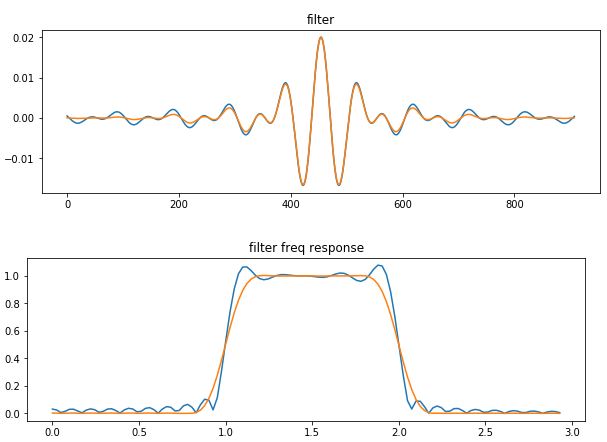바로 프로젝트 적용 가능한 FIR Filter (low/high/band pass filter )를 c나 python으로 만들기
band pass filter 코드가 필요해 인터넷을 검색을 해봤지만, 쓸 만한 코드와 자료가 별로 없어 그냥 만들어 쓰기로 했다.
필요한 공식은 위키피디아에 나와있다.
https://en.wikipedia.org/wiki/Finite_impulse_response
1. filter 크기
FIR filter를 만들 때 filter의 크기(tpas의 크기)를 결정할 때 도움될 수식이 있다.
N=A㏈Fs / 22*Δf
A㏈ : 감쇄될 db
Fs : Sampling Frequency
Δf : frequency bandwidth
출처 : https://www.allaboutcircuits.com/technical-articles/design-of-fir-filters-design-octave-matlab/
def estimatefilterlen(fl,fh,fs,db):
N = int(np.round(db * fs / (22 * (fh-fl)))-1)
return N
2. Low Pass Filter
[ python code ]
def lowpassfilter(f,fs,N):
taps = np.zeros(N)
fc = f / fs
omega = 2*np.pi*fc
middle = int(N/2)
for i in range(N):
if i == middle:
taps[i] = 2*fc
else:
taps[i] =
np.sin(omega*(i-middle))/(np.pi*(i-middle))
return taps
[ c code ]
#ifndef PI
#define PI 3.14159265358979323846
#endif
double *lowpassfilter(double f, double fs, int N)
{
double *filter = NULL;
double fc = 0;
double omega = 0;
int i = 0;
int middle = 0;
if (f <= 0 || fs <= 0 || N <= 0)
return NULL;
filter = (double*)malloc(N*sizeof(double));
if (!filter)
return NULL;
memset(filter, 0, N*sizeof(double));
middle = (int)(N / 2);
fc = f / fs;
omega = 2 * PI*fc;
for (i = 0; i < N; i++)
{
if (i == middle)
{
filter[i] = 2 * fc;
}
else
{
filter[i] = sin(omega*(i - middle))
/ (PI*(i - middle));
}
}
return filter;
}
f = 2.0, fs = 100, N=908 인 low pass filter는 아래와 같은 모양과 주파수 응답 특성을 지닌다.
만약 위 1번의 필터 크기 결정 공식에 따라 필터의 크기를 달리 했을 경우의 예는 아래와 같다.
3. High Pass Filter
[ python code ]
def highpassfilter(f,fs,N):
taps = np.zeros(N)
fc = f / fs
omega = 2*np.pi*fc
middle = int(N/2)
for i in range(N):
if i == middle:
taps[i] = 1 - 2*fc
else:
taps[i] = -
np.sin(omega*(i-middle))/(np.pi*(i-middle))
return taps
[ c code ]
double *highpassfilter(double f, double fs, int N)
{
double *filter = NULL;
double fc = 0;
double omega = 0;
int i = 0;
int middle = 0;
if (f <= 0 || fs <= 0 || N <= 0)
return NULL;
filter = (double*)malloc(N*sizeof(double));
if (!filter)
return NULL;
memset(filter, 0, N*sizeof(double));
middle = (int)(N / 2);
fc = f / fs;
omega = 2 * PI*fc;
for (i = 0; i < N; i++)
{
if (i == middle)
{
filter[i] = 1 - 2 * fc;
}
else
{
filter[i] = - sin(omega*(i -
middle)) / (PI*(i - middle));
}
}
return filter;
}
f = 2.0, fs = 100, N=908 인 high pass filter는 아래와 같은 모양과 주파수 응답 특성을 지닌다.
4. Band Pass Filter
[ python code ]
def bandpassfilter(fl,fh,fs,N):
taps = np.zeros(N)
flc = fl/fs
fhc = fh/fs
omegal = 2*np.pi*flc
omegah = 2*np.pi*fhc
middle = int(N/2)
for i in range(N):
if i == middle:
taps[i] = 2*fhc - 2*flc
else:
taps[i] =
np.sin(omegah*(i-middle))/(np.pi*(i-middle)) -
np.sin(omegal*(i-middle))/(np.pi*(i-middle))
return taps
[ c code ]
double *bandpassfilter(double fl, double fh, double fs, int N)
{
double *filter = NULL;
double flc = 0;
double omegal = 0;
double fhc = 0;
double omegah = 0;
int i = 0;
int middle = 0;
if (fl <= 0 || fh <= 0 || fl >=fh || fs <= 0 || N
<= 0)
return NULL;
filter = (double*)malloc(N*sizeof(double));
if (!filter)
return NULL;
memset(filter, 0, N*sizeof(double));
middle = (int)(N / 2);
flc = fl / fs;
omegal = 2 * PI*flc;
fhc = fh / fs;
omegah = 2 * PI*fhc;
for (i = 0; i < N; i++)
{
if (i == middle)
{
filter[i] = 2*fhc - 2 * flc;
}
else
{
filter[i] = sin(omegah*(i - middle))
/ (PI*(i - middle)) - sin(omegal*(i - middle)) / (PI*(i - middle));
}
}
return filter;
}
fl = 1.0, fh = 2.0, fs = 100, N=908 인 band pass filter는 아래와 같은 모양과 주파수 응답 특성을 지닌다.
5. filtering
만들어진 FIR Filter를 사용하여 실제 샘플데이터를 필터링하는 코드는 아래와 같다. python코드가 간단해 python코드로 설명하겠다.
def filtering(samples, taps):
N = taps.shape[0]
out = np.zeros_like(samples)
if len(samples) <= N:
return out
buffer = [samples[0] for _ in range(N)]
buffer = np.hstack((buffer,samples))
for i in range(len(samples)):
out[i] = np.sum(buffer[i:i+N]*taps.T)
return out[int(N/2):]
필터링은 convolution 연산을 사용한다. 필터의 길이에 해당하는 샘플과 필터의 합성곱의 결과들이 필터링 된 데이터가 된다. 연산을 위해 샘플 앞쪽에 필터의 길이만큼의 빈 데이터나 혹은 샘플의 끝부분 데이터 등을 넣어 추가해야 한다.
필터링의 예제는 아래와 같다.
위와 같은 신호 데이터에 low pass filter를 적용하면 아래와 같은 결과를 얻을 수 있다.
6. windowing ***
FIR Filter에 윈도우를 적용하면 주파수 특성이 좋아지는 것을 볼 수 있다. 아래는 Band Pass Filter에 Hamming 윈도우를 적용해 비교한 것이다.
bpf = bandpassfilter(fl=fl,fh=fh, fs=fs,N=N)
bpfw = bandpassfilter(fl=fl,fh=fh, fs=fs,N=N)*np.hamming(N)
실제 샘플에 적용해 보면 아래와 같은 차이를 볼 수 있다.
위와 같이 단순 Band Pass Filter를 적용할 경우 저주파 영역에 주파수 성분이 나타나는 것을 볼 수 있으나, 아래처럼 hamming윈도우를 filter에 적용하여 필터링 할 경우 저주파 영역의 주파수 성분이 나타나지 않는다.
관련 글















글 잘보았습니다.
답글삭제혹시 filtering 코드를 c로 구현하려면 어떻게 해야할까요?